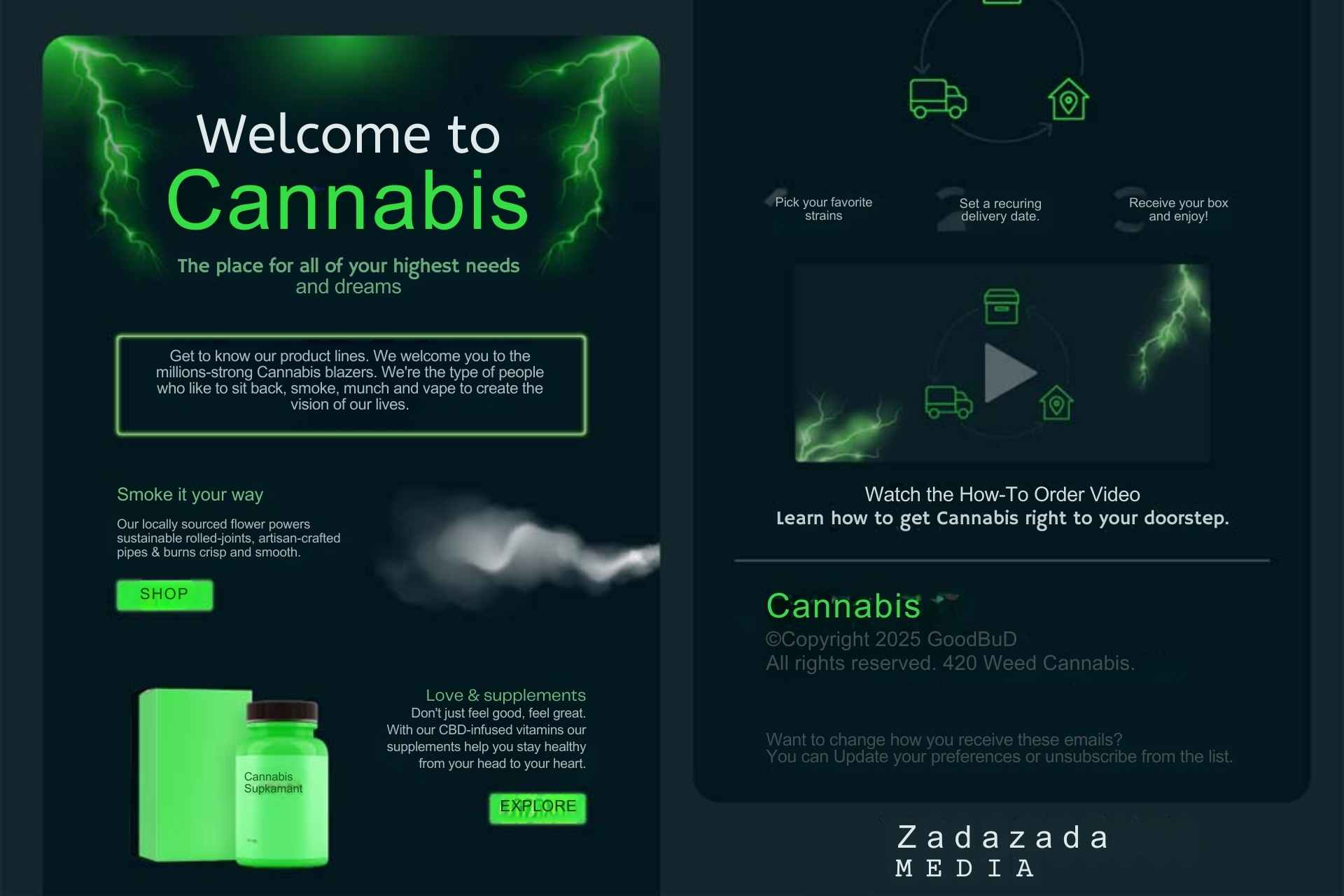
Table of contents:
- Cannabis Industry Email Marketing Overview
- Brief Mention of the Challenges and Opportunities in Designing Effective Cannabis Marketing Emails
- A better understanding of your audience
- Key Design Principles
- An attractive visual appearance
- Aspects of typography and readability
- Design that is mobile-friendly
- Effective Use of Call-to-Action (CTA)
- The personalization and segmentation of data
- Compliance and Legal Considerations
- Analyzing and Optimizing Email Design
- Conclusion
In the vibrant and highly competitive cannabis industry, effective communication is crucial. E-mail marketing is a powerful and efficient method of reaching and engaging customers. However, designing emails for cannabis marketing presents unique challenges and opportunities.
Cannabis Industry Email Marketing Overview
Cannabis businesses cannot do without email marketing. The company provides direct customer service, promotions, and new product information. Given the legal and social complexities surrounding cannabis, email marketing allows for a controlled and targeted approach to reach potential customers and build brand loyalty.
Brief Mention of the Challenges and Opportunities in Designing Effective Cannabis Marketing Emails
Designing effective cannabis marketing emails comes with its own set of challenges, including compliance with strict regulations and overcoming stigmas. However, these challenges also present opportunities to create innovative and impactful designs that not only comply with the law but also captivate and convert your audience.
A better understanding of your audience
Targeting Cannabis Marketing Emails to the Right Audience
Crafting effective cannabis marketing emails begins with understanding your audience. Whether they are seasoned cannabis enthusiasts, curious newcomers, or medical patients, how would you describe them? As soon as you identify your target audience, you can create content and design elements tailored to them.
Tailoring Design Elements to Audience Preferences and Demographics
Once you’ve identified your audience, customize your email design to appeal to their tastes. For instance, younger audiences might appreciate bold, vibrant visuals and interactive elements, while older or medical users might prefer a more straightforward and informative approach.
Key Design Principles
Consistency with Brand Identity
Maintaining consistency with your brand identity in email design is vital. When sending emails, be sure to use the same colors, fonts, and overall aesthetic as your brand. Your subscribers will be able to recognize your brand and trust you as a result of this consistency.
Layout that is clean and simple
It is important to have a clean and simple layout so that your message is clear and easy to understand. It is important to avoid clutter and use white space effectively in your content in order to improve its readability and visual appeal.
A balance between text and visuals
The right balance must be struck between text and visuals. While visuals can grab attention and illustrate your message, text provides the necessary information. Rather than overpowering your content with images and graphics, use them to enhance it.
An attractive visual appearance
Using high-quality graphics and images
Your emails will stand out if you include high-quality images and graphics. Make sure you use high-resolution images that are in line with your brand and that resonate with your audience. For cannabis marketing, consider using images that highlight the product’s quality and benefits.
Incorporating Cannabis-Themed Visuals Tastefully
Cannabis-themed visuals should be used tastefully to avoid perpetuating stereotypes. Opt for sophisticated and modern imagery that reflects the legitimacy and benefits of cannabis products.
Psychological Impact of Color Schemes
People perceive your emails differently based on the colors you use. Green is a natural choice for cannabis marketing, symbolizing growth and health. However, incorporating other colors like blues and earthy tones can evoke feelings of trust and stability.
Aspects of typography and readability
How to Choose the Right Fonts and Sizes
A font’s size and font family determine the readability of a document. Use clean, easy-to-read fonts and ensure the text size is large enough to read on all devices. Fonts with too much decoration can be difficult to read.
Multi-device readability
Mobile devices, including smartphones and tablets, must be able to read your emails. A variety of screen sizes must be able to read the layout and text.
Effectively Using Whitespace and Spacing
A design element that is often overlooked is negative space or whitespace. It helps prevent your emails from looking cluttered and overwhelming. When emails are properly spaced, they are easier for the reader to read and more visually appealing.
Design that is mobile-friendly
Techniques for Responsive Design
Your emails are responsive, so you can view them on any device. Use flexible layouts and scalable images to adapt to different screen sizes. Engaging users is easier with mobile-friendly designs.
A guide to mobile optimization best practices
Optimize your emails for mobile by keeping your design simple, using large buttons for easy tapping, and ensuring your content is concise. Your emails need to load quickly and be easy to navigate, so be sure to keep them in mind when you are sending them to mobile users.
Creating emails that are compatible with different devices
It is important to ensure that the design of your emails renders correctly across a range of devices and email clients. Use tools that simulate different environments to catch and fix any issues before sending.
Effective Use of Call-to-Action (CTA)
Designing Compelling CTAs
Your email’s effectiveness can be significantly increased with a compelling CTA. CTAs should be action-oriented and have contrasting colors to make them stand out.
Placement and Visibility of CTAs
Place your CTAs where they are easily visible, preferably above the fold. This ensures that recipients see the CTA without having to scroll down.
A/B Testing CTAs for Better Performance
Using A/B testing to determine which version of your CTA will work best with your audience can help you determine what will work for them. Test different colors, text, and placements to find the most effective combination.
The personalization and segmentation of data
Designing and personalizing emails
Personalizing your emails can increase their effectiveness. Send tailored content based on your subscribers’ interests and use their names to recommend products.
Engagement Strategies Based on Segmentation
The process of segmenting an email list involves categorizing it according to specific criteria, such as the buyer’s history or the demographics of the audience. As a result, engagement rates are higher because the content is more relevant and targeted.
The Best Examples of Personalized Emails
According to a recipient’s past purchases or preferences, a cannabis company might send personalized emails recommending specific strains or products. Highlighting exclusive offers or content can also make recipients feel valued.
Compliance and Legal Considerations
Understanding Cannabis Marketing Regulations
The marketing of cannabis is heavily regulated. Legal issues can be avoided by understanding and complying with all relevant laws. This includes age restrictions, content limitations, and disclaimers.
Ensuring Email Design Complies with Legal Standards
Ensure your email designs include necessary disclaimers and adhere to legal standards. This might involve including age verification prompts and avoiding any claims that could be deemed misleading.
Including Disclaimers and Age Verification
Disclaimers and age verification are critical in cannabis marketing. Clearly state any necessary disclaimers and use age gates to ensure compliance with legal requirements.
Analyzing and Optimizing Email Design
Tools for Analyzing Email Performance
Email campaigns can be analyzed using a variety of tools. In order to understand what is successful and what is not, it is important to measure open rates, click-through rates, and conversion rates.
Measures to track for effective email design
Track metrics that reflect the effectiveness of your email design. These include engagement rates, conversion rates, and the performance of specific design elements like CTAs.
Iterative Design Improvements Based on Data
Use data to continually improve your email designs. Regularly analyze performance and make adjustments based on what you learn. This iterative approach helps refine your strategy and improve results over time.
Conclusion
Effective cannabis marketing requires effective email design. By understanding your audience, adhering to key design principles, and continuously optimizing your approach, you can create engaging and compliant emails that drive results. Experiment with different designs and always keep the user experience in mind.
Remember, if you need expert assistance with your cannabis email marketing, consider partnering with GoCannabis Marketing. This dynamic industry is our business, and we’re committed to helping you succeed.
Call to Action
Do you have any other questions about Cannabis Email Marketing? See our blog for more information. Please contact our support team at support@gocannabismarketing.com or 1 (470) 791-9755 if you have any questions. Our team at GoCannabis Marketing will be glad to assist you.


